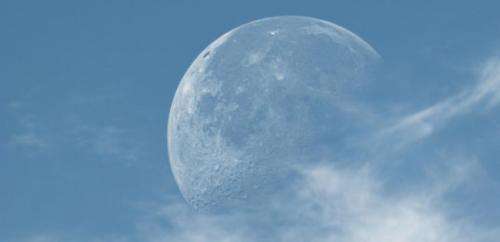Explainer: How do satellites orbit the Earth?

Take a look at the moon and it isn't hard to imagine it as a planet. A 3,476 kilometres-in-diameter ball of rock, with basalt plains and mountain ranges, whose gravitational pull produces tides here on Earth.
Despite its vast mass and gravitational pull, the moon does an excellent job of not falling to Earth. Why? Because the moon is in orbit.
The concepts of gravity and orbits have been developed over centuries by legendary figures of science, including Galileo Galilei, Johannes Kepler, Isaac Newton and Albert Einstein.
Satellites in orbit are routinely used for communication, imaging and navigation – yet many people don't understand how these satellites remain in space.
Going sideways
A common misconception about space travel and weightlessness is that they result from an absence of gravity. While the gravitational pull from the Earth decreases as one goes further into space, it never disappears entirely. Let go of a ball 100,000km above the Earth and it gradually falls.
How do satellites and moons stop themselves from crashing down? By going sideways.
Newton may not have been fun at parties, but he could create a cracking thought experiment. To illustrate the motion of satellites, he created Newton's Cannon.
When you fire a cannon horizontally on Earth, the cannon ball goes some distance as it falls to the ground. Fire the cannon ball faster out of the cannon and it will travel further around the Earth before crashing.
What if you could fire the cannon ball at an unbelievable speed of 8 kilometres per second? The cannon ball would follow the curvature of the Earth, being pulled towards the Earth by gravity but never reaching the ground.
At least it would in Newton's thought experiment, with no air resistance and a magically powerful cannon.
Going up
Newton's Cannon remains a thought experiment but in the 20th century it finally became possible to travel at speeds of 8 kilometres per second. Not with cannons, but with rockets.

Apart from being more comfortable than a cannon, a rocket can travel beyond 100 kilometres altitude and then accelerate to 8 kilometres per second in the emptiness of space. At that speed it takes a mere 90 minutes to circumnavigate the globe.
Once in orbit, the rocket motors can be switched off and a spacecraft can coast around the Earth. It's a sci-fi myth that spacecraft plunge from orbit when their engines are switched off.
The Earth's atmosphere at altitudes between 100 and 1,000 kilometres is exceptionally thin, so it takes anywhere from days to years for a spacecraft to be dragged back to Earth.
If you are inside a spacecraft, high above the world, gravity will pull on you and your spacecraft, and yet you would be weightless.
Weightlessness happens whenever you are being pulled freely by gravity, without resistance (from a surface or the air). Weightlessness can even be felt without going 8 kilometres per second, at the top of a jump or the beginning of a dive.
Going higher
What happens if you fire up the rockets, accelerating to a speed of 10 kilometres per second? Instead of following the curvature of the Earth, your spacecraft will follow a path that takes it far away from Earth.
As your spacecraft pulls away from Earth, it will start slowing down, both vertically and horizontally (due to the conservation of angular momentum). Eventually it will reach a peak altitude (apogee) and fall back towards the Earth, accelerating as it does.
The process now reverses, with the spacecraft picking up speed until it reaches a minimum altitude (perigee). The process then repeats, with the spacecraft tracing an ellipse around the Earth.
What happens if you fire up the rockets again, accelerating to a speed of 11 kilometres per second? Now things get interesting.
Your spacecraft will travel away from the Earth and be slowed by gravity, but the gravitational pull of the Earth drops so rapidly that it will never stop you entirely. Your spacecraft will leave the vicinity of the Earth, to wander through our solar system.
Staying still
While some satellites whiz around the world in 90 minutes, others don't seem to move at all. Weather and TV satellites seem to hover above the equator.
These satellites are in geostationary orbits. As one orbits further from the Earth, the speed required to stay in orbit decreases and the time required to complete an orbit increases.
At almost 36,000km in altitude, an orbit takes a full day to circle the Earth. As the Earth spins on its axis once a day too, these satellites appear fixed in place from our (spinning) Earth-bound perspective.
Go even further from the Earth and orbits take even longer. The moon is a natural satellite 384,000km from Earth and takes just over 27 days to complete a single orbit. Even though the moon is travelling a kilometre every second towards the east, on the spinning Earth the moon rises in the east and sets in the west.
Passing by
We can actually see satellites passing overhead before dawn and after dusk, as they reflect sunlight down towards us.
Some satellites follow the rotation of the Earth and move from west to east. Others have orbits taking them over the poles, and travel north to south or south to north.
Pick the right night and you will see the massive but weightless International Space Station as it circles the globe.
Silently the satellites pass overhead, taking a few minutes to travel from horizon to horizon. To us their passage seems quite serene, even though they are travelling many kilometres every second at altitudes of hundreds of kilometres.
Source: The Conversation
This story is published courtesy of The Conversation (under Creative Commons-Attribution/No derivatives).
![]()





















